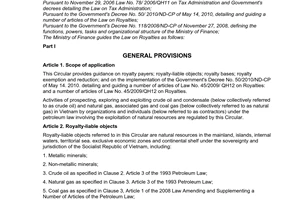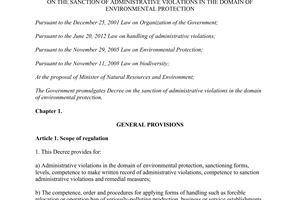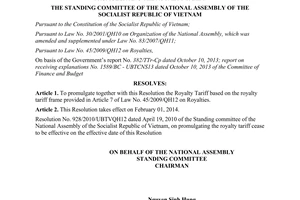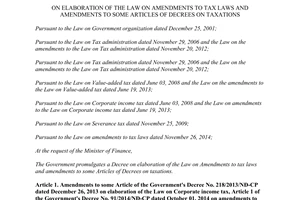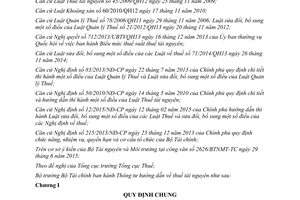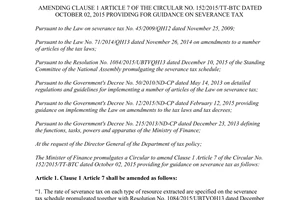Nội dung toàn văn Circular No. 152 /2015/TT-BTC guidance on severance tax
|
MINISTRY OF
FINANCE |
SOCIALIST
REPUBLIC OF VIETNAM |
|
No. 152 /2015/TT-BTC |
Hanoi, October 02, 2015 |
CIRCULAR
GUIDANCE ON SEVERANCE TAX
Pursuant to the Law on Severance tax No. 45/2009/QH12 dated November 25, 2009;
Pursuant to the Law on Mineral No. 60/2010/QH12 dated November 17, 2010;
Pursuant to the Law on Tax administration No. 78/2006/QH11 dated November 29, 2006; the law No. 21/2012/QH13 dated November 20, 2012 on the amendments to the law on tax administration
Pursuant to Resolution No. 712/2013/UBTVQH13 dated December 16, 2013 of Standing Committee of the National Assembly on promulgation of severance tax schedule;
Pursuant to the Law No. 71/2014/QH13 dated November 26, 2014 on amendment to tax laws;
Pursuant to the Government's Decree No. 83/2013/ND-CP dated July 22, 2013 on guidelines for some Article of the Law on Tax administration and the law on the amendments to the law on tax administration;
Pursuant to the Government's Decree No. dated May 14, 2013 on guidelines for some Article of the Law on Severance tax;
Pursuant to the Government's Decree No. 12/2015/ND-CP dated February 12, 2015 on guidelines for the Law on amendments to tax laws and tax decrees;
Pursuant to the Government's Decree No. 215/2013/ND-CP dated December 23, 2013 defining the functions, tasks, entitlements and organizational structure of the Ministry of Finance;
In consideration of opinions of the Ministry of Natural Resources and Environment in Dispatch No. 2626/BTNMT-TC dated June 29, 2015;
At the request of the Director of the General Department of Taxation;
The Minister of Finance promulgates a Circular to provide guidance on severance tax:
Chapter I
GENERAL PROVISIONS
Article 1. Scope
This Circular provides guidance on taxable items; taxpayers, basis for tax calculation, exemption and reduction of severance tax, implementation of the Government's Decree No. 50/2010/ND-CP dated May 14, 2010 (hereinafter referred to as Decree No. 50/2010/ND-CP.
Other regulations of the Ministry of Finance shall apply to crude oil, natural gas, and coal gas.
Article 2. Taxable items
The items subject to severance tax prescribed in this Circular are natural resources within the land, islands, internal waters, territorial sea, contiguous zones, exclusive economic zone, and continental shelves under the sovereignty and jurisdiction of Socialist Republic of Vietnam, including:
1. Metallic minerals.
2. Non-metallic minerals.
3. Products of natural forests, including plants and other products of natural forests other than animals, anise, cinnamon, cardamom planted by taxpayers within the area of natural forests they are given to cultivate and protect.
4. Natural aquatic organisms, including marine animals and plants.
5. Natural water, including: surface water and groundwater other than natural water used for agriculture, forestry, aquaculture, salt production, and seawater used for cooling machines.
Seawater used for cooling machines mentioned in this Clause must comply with regulations on environment, effectiveness of water recirculation, and technical requirements certified by competent authorities. The act of causing pollution when using seawater or using seawater without satisfying environmental standards shall be dealt with in accordance with the Government's Decree No. 179/2013/ND-CP dated November 14, 2013, its instructional documents and/or amendments and/or replacements (if any).
6. Natural bird’s nests other than those collected from construction of houses to attract and raise natural swifts to collect their nest.
Bird’s nests collected from construction of houses to attract and raise natural swifts to collect their nest must comply with Circular No. 35/2013/TT-BNNPTNT dated July 22, 2013 of the Ministry of Agriculture and Rural Development, its instructional documents and/or amendments and/or replacements (if any).
7. The Ministry of Finance shall cooperate with relevant Ministries and agencies in reporting other natural resources to the Government.
Article 3. Taxpayers
Payers of severance tax (hereinafter referred to as taxpayers) are organizations and individuals (hereinafter referred to as entities) that extract natural resources subject to severance tax mentioned in Article 2 of this Circular. Taxpayers in some particular cases:
1. For mineral extraction, taxpayers are the organizations and business households granted the License for mineral extraction by competent authorities.
In case an organization is granted the license for mineral extraction and permitted to cooperate with other organizations and individuals extracting natural resources, and there are separate regulations on taxpayers, the taxpayers shall be identified according to such regulations.
In case an organization is granted the license for mineral extraction and then delegates its affiliates to carry out mineral extraction, each affiliate is a taxpayer.
2. If a joint venture is established among resource-extracting enterprises, the joint venture is the taxpayer;
In case a Vietnamese party and a foreign party participate in the same contract for cooperation in resource extraction, the obligation to pay tax of each party must be specified in the contract. Otherwise, all parties must declare and pay severance tax or appoint a representative to pay severance tax.
3. In case an entity is awarded a construction contract and extracts a certain amount of natural resources that is permitted by the authorities, or the extraction/use of such natural resources is not contrary to regulations of law on resource extraction, such entity must declare and pay severance tax to the local tax authority in the area where natural resources are extracted.
4. Every entity using water from irrigation works for power generation is taxpayer, regardless of sources of capital for the irrigation works.
In case the organization managing the irrigation work supplies water for other entities to produce clean water or water for other purposes (other than power generation), the organization managing the irrigation work supplies water is the taxpayer.
5. In case natural resources that are banned from extraction or illegally extracted are confiscated, subject to severance tax, and permitted to be sold, the organization assigned to sell such natural resources shall pay severance tax whenever it is incurred to its supervisory tax authority before retaining the cost of arrest, auction, reward.
Chapter II
BASIS FOR CALCULATION OF SEVERANCE TAX
Article 4. Basis for tax calculation
1. The basis for calculation of severance tax is the taxable extraction quantity of natural resources, unit price, and tax rate.
2. Severance tax payable in the period
|
Severance tax payable in the period |
= |
Taxable extraction quantity of natural resources |
x |
Unit price |
x |
Tax rate |
|
In case an authority imposes a certain amount of severance tax on a unit of natural resources extracted, severance tax is calculated as follows:
|
Severance tax payable in the period |
= |
Taxable extraction quantity |
x |
Severance tax on a unit of natural resources extracted |
Imposition of severance tax must be based on the database of tax authorities and conform to regulations on tax imposition.
Article 5. Taxable extraction quantity
1. If the quantity or weight of natural resources extracted is determinable, taxable extraction quantity is the actual quantity or weight of natural resources extracted in the tax period.
If the natural resource-derived products obtained are of different classes, quality, and commercial value, taxable extraction quantity is determined according to the extraction quantity of each resource having the same class, quality, and commercial value, or their quantities will be converted to the resource having the highest sales in order to determine the taxable extraction quantity of all natural resources in the period.
Example 1: Enterprise A extract stones after blasting. The stones extracted are of various sizes. They will be sorted by class and quality to determine taxable extraction quantity of each type. In case enterprise A sells part of the stones and grind the remainders into smaller stones of different sizes, taxable extraction quantity is calculated by converting the quantities of stones of different sizes to the one having the highest sales. Enterprise A shall declare and pay tax on the quantity of stones extracted according to the selling price.
2. If the quantity or weight of natural resources is not determinable because they contain various substances or impurities, and natural resources are sold after screening and classification, taxable extraction quantity is calculated as follows:
a) If the substances can be separated, the taxable extraction quantity is determined according to the quantity, weight of the natural resources or each substance obtained after screening and classification.
In case earth, stones, wastes, dregs collected after screening are sold, severance tax on the quantity of natural resources in the wastes, dregs sold shall be paid at corresponding severance tax rates.
Example 2: in case coal extracted from the mine contains impurities, earth, stones, and has to be screened and classified before being sold, the taxable extraction quantity is the quantity of coal that has been screened and classified. In case the wastes sold contains coal and other natural resources, severance tax shall be charged upon taxable natural resources in the wastes at actual selling price and corresponding tax rates.
Example 3: After extracted iron ore is screened, they collected 2 kg of gold nuggets and 100 tonnes of iron ore. Severance tax shall be charged on the quantity of gold nuggets and iron ore obtained. Quantities of other natural resources serving the process of mineral extraction, such as water for screening, will also be determined to calculate tax.
b) If the ore extracted contain various substances (polymetallic ore) and the quantity of each substance cannot be determined after screening and classification, the taxable extraction quantity of each substance depends on the actual quantity of extracted ore and ratio of each substance in the ore. The ratio of each substance in the ore is determined according to the ore sample inspected and approved by competent authorities. In case the ratio of each substance in the ore is different than the ore sample, the taxable extraction quantity will depend on the analysis result given by a competent authority.
Example 4: Enterprise B extracts 1000 tonnes of ore in the month which contains various substances. According to the mining license and substance ratio in the ore sample approved by National Reserve Evaluation Council: copper ore: 60%; silver ore: 0.2%; tin ore: 0.5%.
Taxable quantity of each substance:
- Copper ore: 1,000 tones x 60% = 600 tonnes.
- Silver ore: 1,000 tones x 0.2% = 2 tonnes.
- Tin ore: 1,000 tones x 0.5% = 5 tonnes.
Severance tax shall be calculated according to the unit price and quantity of each substance in the ore.
3. If extracted natural resources are used for further manufacturing and processing instead of being sold, taxable extraction quantity is calculated as follows:
If extracted natural resources are used for further manufacturing and processing instead of being sold, taxable extraction quantity is determined according to quantity of products manufactured in the period and amount of natural resources in a unit of products. Amount of natural resources in a unit shall be declared by the taxpayer according to the project approved by a competent authority and applied technologies. To be specific:
- If the products sold are natural resource-derived products, the amount of natural resources in a unit of natural resource-derived products product shall apply.
- If the products sold are industrial, the amount of natural resources in a unit of industrial products shall apply.
Whether products sold after processing are industrial products or not shall be decided by relevant Ministries.
Example 5: Enterprise A grinds part of the stones for manufacturing of cement for sale. If the quantity of stones used for manufacturing of cement cannot be determined, it will be converted from the production of cement from extracted stones. In this case, enterprise A shall determine its own norms and technical process.
Example 6: Enterprise C extracts 10 tonnes of apatite which consists of 2 tonnes of apatite 1, 3 tonnes of apatite 2, and 5 tonnes of apatite 3. Apatite 1 and apatite 2 are sold, and apatite 3 are used for processing into apatite 1 for sale. Taxable extraction quantity:
- 5 tonnes of apatite 1 and apatite 2;
- Extraction quantity of apatite 1 obtained from the processing of apatite 3.
Example 7: Part of the polymetallic ore extracted by enterprise D is sold as is in Vietnam. The remainder is refined for export. Taxable extraction quantity is calculated as follows:
- Taxable extraction quantity of each substance in the ore being sold in Vietnam is calculated according to on the ratio of each substance in the polymetallic ore approved by National Reserve Evaluation Council and the analyzed ore sample.
- Export quantity: If refined natural resources for export are identified as industrial products by a competent authority, taxable extraction quantity of natural resources is determined according to the ratio of each substance in the polymetallic ore approved by National Reserve Evaluation Council, the analyzed ore sample, and amount of natural resources in a unit of products declared by enterprise D according to its technology process.
4. With regard to natural water used for hydropower generation, taxable extraction quantity of natural resources is the amount of electricity sold by the generating facility to the buyer under a electricity sale contract (or transmitted electricity if there is not electricity sale contract) according to a measurement system that meet Vietnam’s measurement standards. This amount must be confirmed by the buyer and the seller.
5. For natural mineral water, natural hot water, bottled/boxed purified natural water, natural water used for production/business, taxable extraction quantity of natural resources shall be expressed as cubic meter (m3) or liter (l) according to the measurement system that meet Vietnam’s quality measurement standards.
The taxpayer must install meters for monitoring extraction quantity of natural mineral water, natural hot water, and natural water extracted as the basis for tax calculation. The installed meters must have certificates of inspection by Vietnam’s quality measurement standard authorities. A notification of installed meters must be enclosed with the next declaration of severance tax.
If the meters cannot be installed because of objective reasons and thus taxable manufacture cannot be determined, a flat extraction quantity shall be imposed. The tax authority shall cooperate with relevant agencies in determining flat extraction quantity to calculate severance tax in accordance with this Circular.
6. Mechanism for cooperation between tax authorities, resources and environment authorities in management of local resource extraction: According to taxpayers’ declarations of actual extraction quantity in the year at each mine in the statement submitted together with the annual declaration of severance tax at the end of the fiscal year, within 05 working days, the tax authority shall send information about actual extraction quantity in the year at each mine to the resources and environment authority. The resources and environment authority shall compare the extraction quantity at each mine declared by taxpayers with its data. If they are not consistent or violations are suspected, the resources and environment authority shall take actions to determine the actual extraction quantity.
Within 07 working days from the receipt of information sent by the tax authority, the resources and environment authority shall send information to the tax authority for processing as prescribed by the Law on Tax administration.
7. If there are local enterprises that extract, export natural resource-derived products, the tax authority shall determine the actual quantity of exported natural resource-derived products under the mechanism for information exchange in Decision No. QD/BTC dated March 30, 2015 of the Ministry of Finance to calculate the quantity of natural resource-derived products and compare with the extraction quantity on the annual declarations of severance tax submitted by the enterprises. If the taxable extraction quantity declared by the enterprise is inconsistent, the tax authority shall carry out inspection as prescribed by the Law on Tax administration to collect severance tax arrears and impose penalties as prescribed.
Undeclared extraction quantity shall incur severance tax at the rate and taxable price applicable at the time of extraction; If the time of extraction cannot be determined, the tax rate and taxable price prescribed by law at the end of the year in which natural resources are extracted shall apply.
Article 6. Taxable prices of natural resources
Taxable price of a natural resource is the selling price of a unit of natural resource-derived products imposed by the extracting entity exclusive of VAT. This price must not fall below the taxable price imposed by the People’s Committee of the province. Otherwise, the taxable price imposed by the People’s Committee of the province shall apply.
If the cost of transport of natural resource-derived products and selling price are written on separate invoices, the taxable price is the selling price exclusive of transport cost.
1. With regard to natural resources of which unit prices of natural resource-derived products can be determined
Taxable price is the selling price of a unit of natural resource-derived products of the same class and quality exclusive of VAT and extracted within the month; Selling price of a unit of natural resource equals (=) total revenue (exclusive of VAT) from the sale of the resource divided by (:) total quantity of the same resource sold in the month.
If no revenue is earned though the natural resource still extracted in the month, taxable price is the weighted mean of taxable unit price of the latest month in which revenue is earned. If the weighted mean of taxable unit price of the latest month in which revenue is earned is lower than the taxable price imposed by the People’s Committee of the province, the taxable price imposed by the People’s Committee of the province shall apply.
In case organizations being legal entities extract natural resources for a corporation/conglomerate under contracts, or sell natural resources at prices decided by such corporation/conglomerate, the taxable prices shall be decided by the corporation/conglomerate but not lower than the prices imposed by the People’s Committee of the province where natural resources are extracted.
2. With regard to any natural resource of which unit price is not determined because it contains various substances
Taxable price is the selling price of each substance according to the total revenue from selling the resource in the month (exclusive of VAT), ratio of each substance approved by a competent authority, and sale of resources on the sale invoices corresponding to each substance.
Example 8: Enterprise E extracts 1,000 tonnes of ore, the ratio of each substance in the analyzed ore sample is: copper: 60%; silver: 0.2%; tin: 0.5%.
Taxable extraction quantity of each substance:
- Copper: 1,000 tonnes x 60% = 600 tonnes.
- Silver: 1,000 tones x 0.2% = 2 tonnes.
- Tin: 1,000 tones x 0.5% = 5 tonnes.
In the month, enterprise E sells 600 tonnes of ore for VND 900 million. Taxable price of each substance in the ore is determined as follows:
- Revenue from the sale of copper in the month: VND 900 million x 60% = VND 540 million
- Taxable price of copper: VND 540 million/360 tonnes
- When declaring and paying severance tax, the taxpayer shall pay tax on 600 tonnes of copper ore at the aforesaid taxable price and corresponding tax rate.
The taxable prices of silver and tin in 1,000 tonnes of ore extracted in the month are calculated similarly.
3. With regard to resources that have to be processed before being sold (whether domestically or exported)
a) When selling natural resource-derived products, taxable price is the unit price of natural resource-derived products (when sold domestically) according to the sale of natural resources on the sale invoices or customs value of exported natural resource-derived products (when exported) exclusive of export tax on the quantity of export natural resources according to export documents but not lower than the taxable price imposed by the People’s Committee of the province.
Customs values of exported natural resource-derived products shall comply with regulations on customs values of exported goods of the Law on Customs, its instructional documents, and amendments (if any).
b) When selling industrial products, taxable price equals (=) selling price of the industrial products minus (-) processing cost but not lower than the taxable price imposed by the People’s Committee of the province.
Processing cost depends on the processing technologies of the enterprise according to an approved project exclusive of the costs of extraction, screening, enrichment.
c) If the taxable price determined by the taxpayer is lower than that imposed by the People’s Committee of the province, the latte shall apply. If the product is not on the price list of the People’s Committee of the province, the tax authority shall cooperate with relevant agencies in inspecting and imposing tax according to regulations of law on tax administration.
d) When extracted natural resources are processed into natural resource-derived products, taxable prices shall be applied on a case-by-case basis as prescribed by this Article.
Example 9: During the refinement of ore, they obtain 0.05 tonnes of copper ore from 01 tonnes of cast iron. The selling price of copper ore is VND 8,500,000/tonnes, thus taxable price of 0.05 tonne of copper ore is VND 8,500,000. If copper ore is processed into industrial products, taxable price equals (=) the selling price of industrial products minus (-) processing cost at the rate imposed by the People’s Committee of the province to calculate severance tax on the quantity of copper ore processed.
4. Taxable prices in some cases:
a) Taxable price of natural water used for hydroelectricity generation is the average selling price of electricity.
Average selling price of electricity for hydroelectricity producers to calculate severance tax shall be announced by the Ministry of Finance.
b) Taxable price of timber is the selling price at the depot (where timber is stored or extracted). If this price cannot be determined, taxable price depends on the taxable prices imposed by the People’s Committee of the province as instructed in Clause 6 of this Article.
c) For natural mineral water, natural hot water, bottled/boxed purified natural water, natural water used for production/business that are not for sale, taxable prices shall be imposed by the People’s Committee of the province under the rules prescribed in Clause 5 of this Article.
dd) Tax authority shall inspect and impose taxes upon entities extracting natural resources that do not fully comply with regulations on bookkeeping. In this case, taxable extraction quantity shall depend on the inspection result; taxable prices are those imposed by the People’s Committee of the province in that period.
5. The People’s Committees of provinces shall issue a new taxable price schedule annually as follows:
5.1. The taxable price schedule shall contain information as the basis for determination of severance tax on extraction of natural resources in the province in accordance with policies and law, including: norms for use of natural resources as the basis for conversion from natural resource-derived products or industrial products into quantity of extracted natural resources in the natural resource-derived products and industrial products; corresponding taxable prices of extracted natural resources and natural resource-derived products, where:
a) Norms for use of natural resources as the basis for conversion from natural resource-derived products or industrial products into quantity of extracted natural resources in the natural resource-derived products and industrial products of enterprises in the province are determined according to the enterprises’ declaration and must be consistent with the reports made by other agencies and organizations in terms of content, quality, extraction quantity, extraction methods, and ratio of obtainment in the province where natural resources are extracted;
b) Taxable prices on the price list are prices for extracted natural resources and natural resource-derived products corresponding to properties of natural resources and natural resource-derived products extracted, processed by enterprises in the province, determined according to documents, sale contracts of enterprises/organizations in the province in terms of quality and quantity of each type of natural resources, prices of natural resource-derived products on the local market and adjacent markets, except for the case mentioned in Point c Clause 5 of this Article.
c) Taxable prices of extracted natural resources used for further production and processing instead of being sold are calculated as follows:
c1) For resources used for further production or processing into natural resource-derived products, taxable prices are selling prices of natural resource-derived products exclusive of VAT (if sold domestically) or customs value exclusive of export duty (if exported);
c2) For resources used for further production or processing into industrial products for domestic sale or export, taxable prices are selling prices (if sold domestically) or customs value (if exported) of industrial products minus (-) export duty (if any) and processing cost.
Processing cost mentioned in c.2 shall comply with instructions of relevant Ministries, the Ministry of Finance, and determined by the Department of Finance of the province in cooperation with tax authorities, resources and environment authorities, relevant specialized agencies, then submitted to the People’s Committee of the province for approval according to the processing technologies under approved projects and business outcomes of the enterprises extracting, processing natural resources in the province, but do not include the costs of extraction, screening, enrichment.
5.2. Taxable prices imposed by the People’s Committees of provinces must conform to the bracket of taxable prices promulgated by the Ministry of Finance.
5.3. The agencies appointed by the People’s Committee of the province shall cooperate with relevant agencies in proposing the taxable price schedule to the People’s Committee of the province by December 31 for announcement on January 01 of the succeeding year. In the year, if the selling price of a type or resource fluctuates beyond the bracket of the Ministry of Finance, the Ministry of Finance must be notified to make prompt adjustments.
5.4. Tax authorities assigned to collect severance tax shall post the taxable price schedule at their offices and send it to General Department of Taxation for developing a database about taxable prices.
Article 7. Tax rate
1. The rates of severance tax on each type of resource extracted are specified on the severance tax schedule promulgated together with Resolution No. 712/2013/UBTVQH13 dated December 16, 2013 of Standing Committee of the National Assembly and its amendments (if any).
2. Tax rates on natural mineral water, natural hot water, bottled/boxed purified natural water, extracted natural water in some cases:
a) Natural mineral water, natural hot water, bottled purified natural water (including natural water in big bottles or tanks that can be divided into smaller bottles/boxes) apply the same rate of severance tax;
b) Natural water used for hydroelectricity generation, business/production that contains natural mineral water or natural hot water that, according to documents about design and technological process of production/service provision, have been determined by competent authorities as not used for producing/selling natural mineral water, natural hot water, bottled/boxed purified natural water, corresponding rates of severance tax shall apply according to their uses.
Chapter III
REGISTRATION, DECLARATION, PAYMENT OF SEVERANCE TAX
Article 8. Registration, declaration, payment of severance tax
Registration, declaration, payment of severance tax shall comply with the Law on Tax administration, its instructional documents and amendments (if any).
Apart from general regulations, declaration, payment of severance tax on mineral extraction must also comply with Article 9 of this Circular.
Article 9. Declaration of severance tax on mineral extraction
1. Organizations and business households extracting natural resources shall send a notification to tax authorities of their methods of determining taxable prices of each type of resource extracted together with the declaration of severance tax of the first month in which natural resources are extracted. If the method is changed, the supervisory tax authority must be notified within the month in which the change is made.
2. Taxpayers shall make monthly declaration of tax on the entire extraction quantity in the month (regardless of quantity in stock and undergoing processing).
3. When making the annual/terminal declaration, the taxpayer must enclose a list of specific extraction quantities in the year at each mine with the declaration. Severance tax depends on the tax rate, extraction quantity, and taxable price. To be specific:
a) Taxable extraction quantity is the total quantity of natural resources extracted in the year, regardless of quantity in stock and undergoing processing.
If the sale quantity includes both natural resource-derived products and industrial products, the quantity of resources in natural resource-derived products and industrial products must be converted into extraction quantity according to the norms for use of natural resources determined by taxpayers themselves.
b) Taxable price is the average selling price of a unit of natural resource-derived products, which equals (=) total revenue from the sale of resources divided by (:) quantity of resources sold in the year.
Chapter IV
EXEMPTION AND REDUCTION OF SEVERANCE TAX
Article 10. Severance tax exemption
The cases of exemption from severance tax are specified in Article 9 of the Law on severance tax and Article 6 of Decree No. 50/2010/ND-CP including:
1. Entities extracting natural marine organisms.
2. Entities extracting branches, firewood, bamboo, rattan, etc. serving everyday life.
3. Entities extracting natural water for hydroelectricity generation serving everyday life of households and individuals.
4. Natural water extracted by households and individuals serving their everyday life.
5. Land areas given/leased out to organizations and individuals and used on the spot; earth used for leveling, construction of security, military works, dykes.
Earth extracted and used on the spot eligible for tax exemption include sand, rock, gravel in the earth without specific substances and is used as is for leveling or construction. If earth is transport elsewhere for use or for sale, severance tax must be paid as prescribed.
6. The Ministry of Finance shall cooperate with relevant Ministries and agencies in proposing other cases of exemption from severance tax to the government, which will be considered and decided by Standing Committee of the National Assembly.
Article 11. Reduction of severance tax
The cases of reduction of severance tax are specified in Article 9 of the Law on severance tax and Article 6 of Decree No. 50/2010/ND-CP including:
1. Taxpayers who suffer from a natural disaster, conflagration, or accident that inflicts damage the declared resources may be given exemption or reduction of severance tax on the amount of damaged resources. If tax has been paid, taxpayers shall receive a refund or have it offset against severance tax payable in the next period.
2. The Ministry of Finance shall cooperate with relevant Ministries and agencies in proposing other cases of severance tax reduction to the government, which will be considered and decided by Standing Committee of the National Assembly.
Article 12. Procedures for exemption, reduction of severance tax
Procedures for exemption, reduction of severance tax, the power to grant exemption, reduction of severance tax shall comply with the Law on Tax administration, the law on the amendments to the law on tax administration, and their instructional documents.
Chapter V
IMPLEMENTATION
Article 13. Implementation
1. The People’s Committees of provinces shall:
a) Direct Departments of Finance to cooperate with Departments of Natural Resources and Environment and Departments of Taxation in formulating their taxable price schedules; regularly review and adjust the schedules to market developments.
b) Direct tax, finance, resources and environment authorities, State Treasuries, and relevant agencies to cooperate in severance tax administration as instructed by this Circular.
2. This Circular comes into force from November 20, 2015 and replaces Circular No. 105/2010/TT-BTC dated July 23, 2010 of the Ministry of Finance.
Difficulties that arise during the implementation of this Circular should be reported to the Ministry of Finance for consideration./.
|
|
PP MINISTER |
------------------------------------------------------------------------------------------------------
This translation is made by LawSoft and
for reference purposes only. Its copyright is owned by LawSoft
and protected under Clause 2, Article 14 of the Law on Intellectual Property.Your comments are always welcomed



